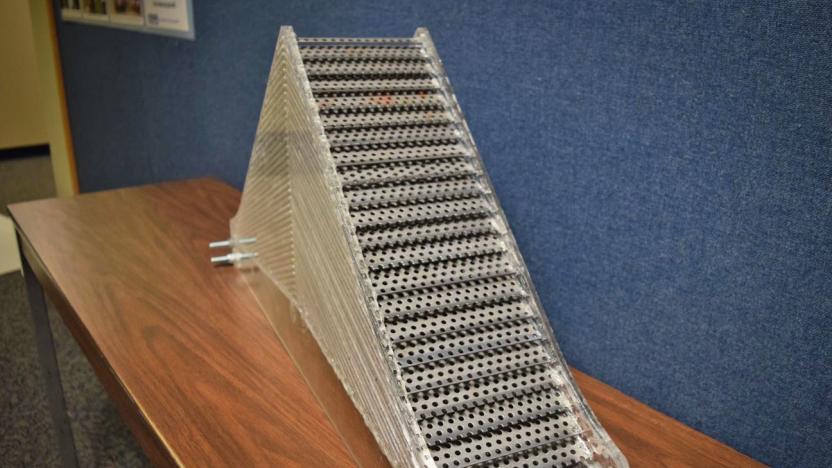CloakingDevice
Latest

Researchers create an acoustic cloaking device that works underwater
The concept of a cloaking device has a lot of appeal and though we're far from being able to make 3D objects invisible to the human eye, researchers continue to develop new ways in which to shield objects from other sorts of detection. At the Meeting of the Acoustical Society of America taking place this week in Minnesota, Penn State University researchers described a design they've developed that allowed a 3-foot-tall pyramid made from perforated steel plates to deflect sound waves in a way that could make it invisible to instruments like sonar.

Plasmonic cloak makes objects invisible, but only in the microwave region of the spectrum
Okay, so we're not up to USS Pegasus levels yet, but for the first time researchers have been able to cloak a three dimensional object. Don't start planning your first trip to the Hogwarts library restricted section just yet though, the breakthrough is only in the microwave region of the EM spectrum. Using a shell of plasmonic materials, it's possible to create a "photo negative" of the object being cloaked in order to make it disappear. The technique is different to the use of metamaterials, which try to bounce light around the object. Instead, plasmonics try to deceive the light as to what's actually there at the time -- but because it has to be tailored to create a "negative image" of the object you're hiding, it's not as flexible, but it could be an important step on the road to that bank heist we've been planning.

US physicists build teensy 2D cloaking device
Drop what you're doing, friend. Cloaking devices are real now, meaning all we need are force fields and some spandex jumpsuits and we'll be bonafide dwellers of the future. The good news comes to us from physicists at the University of Maryland, lead by Igor Smolyaninov, who successfully cloaked a 10 micron gold ring by bending two dimensions of visible light. This follows up successful research last year that had worked out an invisibility cloak in the electromagnetic spectrum, but is still a far cry from a true 3D cloaking device, since such an object would have to bend light waves both magnetically and electronically simultaneously -- this 2D model is just pushing around "surface plasmons" created out of the light waves. While the tech probably won't make the jump to 3D cloaking, it might be used in computer chips or as a replacement for fiber optics some time down the road, which we suppose is alright.

Duke scientists build theorized invisibility cloak. Sort of.
Yes, everyone wants an invisibility cloak. Yes, it's been theorized and in development before. But now, what our friends across the pond have only imagined, scientists at an American university have actually built. A group of brainiacs at Duke University have built a device (based on the Imperial College London theory) that can deflect microwave beams so the beams flow around an object almost as if nothing was there, with not too much distortion (but only in two dimensions). In order to do this, the group built a series of concentric circles made up of "metamaterials," or "artificial composites that can be made to interact with electromagnetic waves in ways that natural materials cannot reproduce." Don't get too excited yet, as scientists warn that this is merely a "baby step." The next step is to make the cloak work in three dimensions, and make improve the cloak's effectiveness. And even still, we're a long way off from making something completely disappear from visibility, which "would have to simultaneously interact with all of the wavelengths, or colors, that make up light." said David R. Smith, a member of the research squad. Hey Duke team, if you ever need human test subjects, we'd definitely be willing to volunteer.[Via The Associated Press]

UK scientists working on cloaking device
We've heard of these kinds of guys before. They've spent too much time engrossed in Harry Potter books or old Star Trek episodes, and dream of some sort of device that will make them invisible. Every couple of years, one of them surfaces with a new idea about a "cloaking device" that can bend light around solid objects, making them appear to be invisible. This time, two separate teams in the UK are racing to show that the concept is feasible. One group, at Imperial College in London, believes that light-bending metamaterials can be produced within the next decade. Meanwhile, two mathematicians have published a study in the Proceedings of the Royal Society, which claims that a "superlens" placed close to an object could produce an "anomalous localized resonance," essentially rendering the underlying object invisible by creating a phantom light wave using the same frequency. The scientists envision building a device soon -- one that could conceivably cloak particles of dust. We'll check back with both parties in a few years. In the meantime, we'd like to present our detailed artist's rendering, prepared at great cost and with much research, which we believe truly shows what a cloaked object will look like to the naked eye. Read - MetamaterialsRead - Superlens


